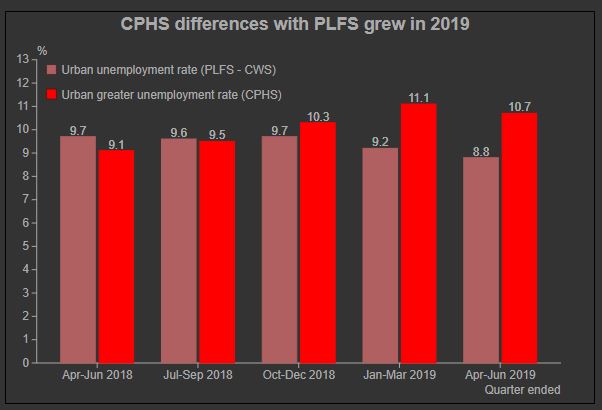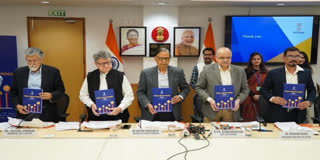Urban unemployment falls sharply in 2018-19: Report
The unemployment rates given by CPHS and PLFS match very closely. According to the PLFS, the unemployment rate in 2018-19 was 8.8 per cent. According to CPHS, the greater unemployment rate was 8.78 per cent. Greater unemployment estimates include those who are unemployed, are willing to work and are looking for jobs as well as those who are unemployed, are willing to work but are not actively looking for jobs.

Hyderabad: The National Statistical Office released results of its Periodic Labour Force Survey (PLFS) for the year 2018-19 and also the quarterly urban estimates till April-June 2019 quarter. The reports were released in the first week of June 2020.
The year of reference for the annual report is July 2018 through June 2019 and the sample size for the annual survey was 101,579 households.
Compared to 2017-18, in 2018-19, the labour participation rate had increased, the employment rate (called working population ratio in the report) had improved and the unemployment rate had declined.
PLFS data indicated a fall in the unemployment rate. By the usual status, the unemployment rate fell from 6.1 per cent in 2017-18 to 5.8 per cent in 2018-19, implying a fall of 0.3 percentage points. The unemployment rate is higher at 8.8 per cent when measured by the current weekly status. And the fall is smaller at only 0.1 percentage points.
The unemployment rate was unchanged for men at 8.8 per cent but fell by 0.4 percentage points for women from 9.1 per cent to 8.7 per cent.
The rise in labour participation rate and simultaneous fall in unemployment rate translates into an increase in the employment rate. This rose from 46.8 per cent in 2017-18 to 47.3 per cent in 2018-19. Interestingly, the employment rate for men fell from 71.2 per cent to 71 per cent. This fall was concentrated only among urban men.
Read more:Economy can't be revived unless medical science finds an answer to Coronavirus
On comparing PLFS and the Consumer Pyramids Household Survey (CPHS) of the Centre for Monitoring Indian Economy (CMIE), CPHS indicated a lower labour participation rate than PLFS. The difference is particularly stark in female labour participation rates. While the LPR for men in PLFS was 74.9 per cent in 2018-19, in CPHS it was 72.5 per cent. LPR for women in PLFS was 21.6 per cent but much lower at 12.4 per cent in CPHS.

The unemployment rates given by CPHS and PLFS match very closely. According to the PLFS, the unemployment rate in 2018-19 was 8.8 per cent. According to CPHS, the greater unemployment rate was 8.78 per cent. Greater unemployment estimates include those who are unemployed, are willing to work and are looking for jobs as well as those who are unemployed, are willing to work but are not actively looking for jobs.
Labour participation rate improved marginally from 48.4 per cent in 2017-18 to 48.5 per cent in 2018-19, on a current weekly status basis. The improvement is very marginal. It is also concentrated in the labour participation of rural women.
Labour participation of rural women improved from 21.7 per cent in 2017-18 to 22.5 per cent in 2018-19. There was a small improvement in the labour participation rate of women in urban India as well - from 19.6 per cent to 19.7 per cent. But, the labour participation rate of men declined - substantially in urban India from 74.1 per cent to 73.7 per cent and in marginally in rural India from 75.6 per cent to 75.5 per cent.
Labour participation rate of women in rural India shot up by 0.8 percentage points on a current weekly basis and by a sharp 1.8 percentage points by the usual status. This does not quite sit well with the sharp slowdown in agriculture during 2018-19 seen in other official data. Growth dropped from 5.9 per cent in 2017-18 to 2.4 pe cent in 2018-19. The economy as a whole (real gross value added) slowed down from 6.6 per cent in 2017-18 to 6 per cent in 2018-19.






